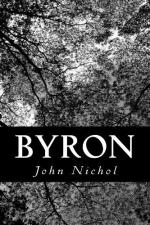[Footnote 1: Mr. Trelawny
says that Thyrza was a cousin, but that on
this subject Byron was always
reticent. Mr. Minto, as we have seen,
associates her with the disguised
girl of 1807-8.]
After a series of vain protests, and petulant warnings against her cousin by marriage, who she said was punctual at church, and learned, and knew statistics, but was “not for Conrad, no, no, no!” Lady Caroline lapsed into an attitude of fixed hostility; and shortly after the crash came, and her predictions were realized, vented her wrath in the now almost forgotten novel of Glenarvon, in which some of Byron’s real features were represented in conjunction with many fantastic additions. Madame de Stael was kind enough to bring a copy of the book before his notice when they met on the Lake of Geneva, but he seems to have been less moved by it than by most attacks. We must however, bear in mind his own admission in a parallel case. “I say I am perfectly calm; I am, nevertheless, in a fury.” Over the sad vista of the remaining years of the unhappy lady’s life we need not linger. During a considerable part of it she appears hovering about the thin line that separates some kinds of wit and passion from madness; writing more novels, burning her hero’s effigy and letters, and then clamouring for a lock of his hair, or a sight of his portrait; separated from, and again reconciled to, a husband to whose magnanimous forbearance and compassion she bears testimony to the last, comparing herself to Jane Shore; attempting Byronic verses, loudly denouncing and yet never ceasing inwardly to idolize, the man




